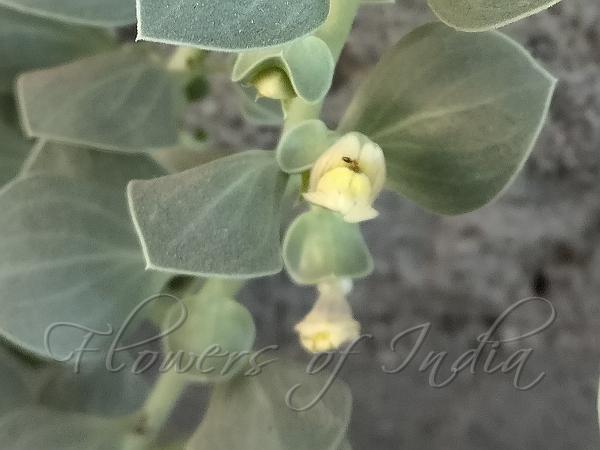|
| Glaucous Dog-Flower |
|

|

| File size | 215393 |
| Original date | 10/31/18 5:59 PM |
| Resolution | 2610 x 4640 |
| Flash | Flash did not fire, auto |
| Focal length | 4.26mm |
| Exposure time | 1/24s |
| Aperture | 2.0 |
| Focus Distance | |
| Metering Mode | Spot |
| Camera make | OnePlus |
| Camera model | ONEPLUS A3003 |
| Sensor type | OneChipColorArea |
|
|
|
|
Photo: |
Botanical name: Schweinfurthia papilionacea Family: Plantaginaceae (Isabgol family)
Synonyms: Antirrhinum papilionaceum, Antirrhinum glaucum, Linaria papilionacea
Synonyms: Antirrhinum papilionaceum, Antirrhinum glaucum, Linaria papilionacea
Glaucous Dog-Flower is an erect, hairless herb growing
up to 30 cm high. Flowers are borne in leaf-axils, on flower-stalks as
long as the leaf-stalk. Flowers are up to 1.2 cm long, white with
purple veins. Stamens 2, epipetalous; anthers basifixed, two lobed,
longitudinally splitting. Sepal-cup is 5-partite; upper segment broadly
ovate, almost heart-shaped, pointed; rest lanceshaped. Ovary superior
with axile placentation; stigma bifid. Leaves are very much variable in
size and shape, basal one ovate or obovate, becoming spoon-shaped in
upper portions, pointed, often apiculate, entire, hairless or sparsely
clothed on both sides with very minute hairs, base usually narrowed
into a short leaf-stalk, somewhat fleshy. Fruit is a spherical capsule,
2-celled oblique, deflexed when mature splitting by wall splitting.
Glaucous Dog-Flower is found in E. Arabian Peninsula, Iran to NW India.
Medicinal uses: The herb is credited with
tonic, diuretic, antipyretic properties and useful
in typhoid and
diabetes. The powdered leaves and fruits are sold as a drug. It is
prescribed by Vaids (native practitioners)
in typhoid fever.
The herb is credited with
tonic, diuretic, antipyretic properties and useful
in typhoid and
diabetes. The powdered leaves and fruits are sold as a drug. It is
prescribed by Vaids (native practitioners)
in typhoid fever.
Medicinal uses:
 The herb is credited with
tonic, diuretic, antipyretic properties and useful
in typhoid and
diabetes. The powdered leaves and fruits are sold as a drug. It is
prescribed by Vaids (native practitioners)
in typhoid fever.
The herb is credited with
tonic, diuretic, antipyretic properties and useful
in typhoid and
diabetes. The powdered leaves and fruits are sold as a drug. It is
prescribed by Vaids (native practitioners)
in typhoid fever. | Identification credit: Sarman Ratiya | Photographed in Anjar, Kutch, Gujarat. |
• Is this flower misidentified? If yes,